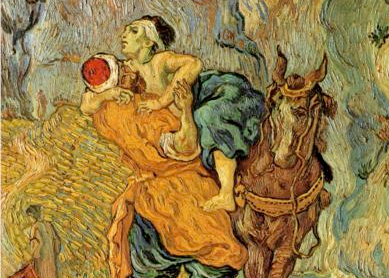The Prodigal Son is a famous parable about a wayward son who returns home. The son had demanded his inheritance, left home, and lost everything. When he was destitute and hungry, he decided to return home. His loving, compassionate father receives his son back with a celebration, but his angry, resentful brother complains about his father’s extravagant welcome of his estranged younger brother.
The Prodigal Son is the longest, most complex, and perhaps most loved of Jesus’s parables. Part of the parable’s power comes from how it evokes compelling human themes and invites readers to identify with its memorable characters. In addition, the parable’s ambiguities add to the mystery of the characters and plot, thereby encouraging readers to engage with the intriguing questions that the parable leaves unanswered.
Does the prodigal son repent?
After he lost everything, the prodigal son “came to himself” (Luke 15:17). Most interpreters understand this ambiguous description as meaning that the son repents. In the context of Luke 15, as the last of the “lost and found” parables (Lost Sheep, Lost Coin, and Lost Son), the story certainly reads as one of repentance and the resulting celebration (see Luke 15:1–2, 6–7, 9–10, 24, 32).
Another possible interpretation, however, is that the son merely “came to his senses.” This interpretation fits better with other details in the story. For example, Luke’s preferred term for repentance is not used here and “came to himself” in Luke-Acts never clearly refers to repentance (e.g., Acts 12:11, where it means “realized”). The fact that the son rehearses his speech also can raise suspicions that he was still selfishly trying to manipulate his father—like when he earlier asked for his inheritance. Echoes of the Hebrew Bible (e.g., the Pharaoh in Exod 10:16) also persuade some readers that the prodigal son does not repent but shrewdly concocts an insincere plan so he will no longer be hungry. In addition, when the inner thoughts and plans of characters under duress are revealed in Luke—such as the Rich Fool (Luke 12:16–20) and the Unjust Judge (Luke 18:2–5)—their portraits tend to remain negative. In Jesus’s parable, there is no unambiguous, heartfelt expression of regret, repentance, or appreciation of the love of his father. There is simply the son’s desire not to starve.
This ambiguity about whether the son repents suggests something even more radical about the father’s compassion: the same extravagant, loving actions are offered whether or not the son was truly repentant. This parable insists that mercy should be given to those in need even if they may be—or appear to be—undeserving.
What does the parable want from its readers?
James Weldon Johnson’s poem “The Prodigal Son” claims that the father symbolizes “God Almighty” and “ev’ry” person “ev’rywhere” identifies with one of the two sons. As the poem illustrates, the parable engages its readers with compelling, universal themes of human relationships—such as sibling rivalries, generational conflicts, and the restoration of community/family—but its genius also resides in the ways in which it inspires readers to identify with its characters.
Some can identify with the prodigal son returning—or needing to return—home to his father. Others can identify with the elder brother who is angry at his brother and jealous of their father’s extravagant welcome of the prodigal. Both brothers, the parable argues, should “come to themselves,” end their self-estrangement, and be restored to full community.
What the parable really wants from its readers, however, is revealed in the father’s motivation: he “was filled with compassion” for his son whom he said (metaphorically) “was dead” but now “is alive again” (Luke 15:24, 32). This crucial rare insight into the father’s motivation builds on earlier scenes in Luke: Jesus’s compassion on a widow whose only son had died (Luke 7:11–17) and the Good Samaritan’s compassion for a “half-dead” man (Luke 10:30–33). Compassion connects these three stories, all of which in some way also revolve around a death, whether real, potential, or metaphorical.
In the Prodigal Son parable, then, the father models the compassion that, in Luke, Jesus shows for others, that Jesus proclaims God embodies, and that Jesus commands his followers to have for all human beings.
The parable thus exhorts its readers to identify with the father, even if he symbolizes God in the parable, by showing compassion. As the Lukan Jesus had already told his followers, if they wanted to be “children of the Most High,” they must “be merciful, just as your Father is merciful” (Luke 6:35–36).
Did you know…?
- The Prodigal Son is the longest, most referenced, and most complex of Jesus’s parables.
- “Prodigal” can mean “wasteful” or denote “someone who returns after an absence.”
- The first sentence of the parable evokes the Hebrew Bible theme of sibling rivalry and strife, where the younger son is favored (e.g., Jacob and Joseph).
- Carob pods, perhaps pods of an evergreen tree (Ceratonia siliqua) that has sweet seeds when ripe, were usual fodder for animals and food for desperate humans. A rabbinic commentary, Leviticus Rabbah 13.4, notes that “when Israelites are reduced to eating carob pods, they repent.”
- The first clear self-identification with the prodigal son in visual art is Albrecht Dürer’s The Prodigal Son amongst the Pigs (1496).
Image Credit: Albrecht Durer, The Prodigal Son amongst the Pigs, 1496, engraving on laid paper, 24.9 x 19 cm (cropped). Courtesy The National Gallery of Art.





